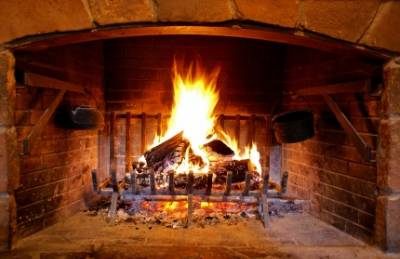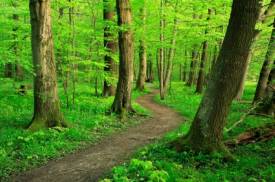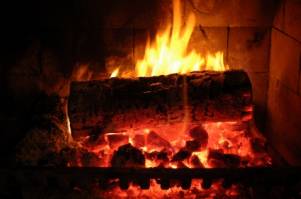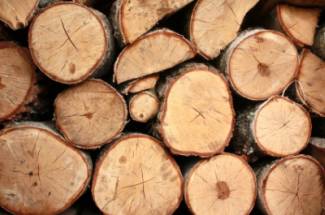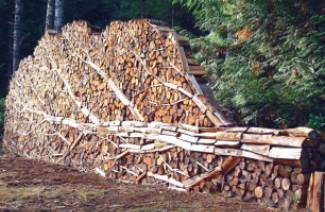|
Wood Burning
I have to admit a fondness for wood burning as an alternative energy source. Nothing seems quite as cozy as sitting by a fire with your family on a winter night. I know, I know, it’s still burning and produces carbon. Some people have environmental concerns about burning wood for heat. I address these concerns on another page: Environmental Effects of Wood Burning The bottom line is that wood is a practical, widely available renewable source of energy. Done properly, it’s environmentally sound. We need to consider wood burning in our alternative energy mix. Besides, I just like fireplaces. Fireplaces aren’t necessarily the most efficient wood burning devices (although some can be pretty darn efficient), but they sure add ambiance to a home. Other ways of burning wood for home heat are: Wood Stoves Wood burning furnaces and boilers Here's a way not to do it: On this page I’m going to discuss a few principles associated with using wood as fuel. Principles Of Wood Burning
In parts of the country wood is readily available it’s a renewable resource. In fact a properly managed woodlot can be a healthier ecosystem than an untended lot. Proper woodlot management culls trees to produce fuel for home heating while trees suitable for lumber and other use are left to grow. An old rule of thumb is that a managed wood lot can produce at least ½ full cord of firewood per season. That's a very rough rule - the sustainability varies greatly with the species. Some people heat their home exclusively by burning wood. Others use wood as a supplemental source of heat. I'm with the latter group. What’s Burning When We Burn Wood
When we burn wood, we're burning both resins impregnated in the wood and the carbon structure of the wood, which is charcoal. The visible flames in a fire are the volatile resins combusting. The glowing embers are the charcoal burning. Several different resins in the wood ignite at different temperatures. If the fire is slow burning, the temperature might not be hot enough to ignite all of the resins. There are a couple of problems with this. First, it’s inefficient. If the resins don’t burn, you’ve lost the heat they could have produced. Secondly, it's dirty and dangerous. The resins are solid or semi-liquid at room temperature (think pine pitch). When we ignite a piece of wood, we’re raising the temperature enough to vaporize an ignite some of the more volatile resins. Some resins vaporize but don’t burn if the temperature isn’t hot enough. Aside from the lost heat there are another problems – air pollution and chimney fires. If the resins exit the chimney, they become air pollution. Sometimes they cool enough as they rise in the chimney to condense back into a solid form on the sides of the chimney. This residue is called creosote. If the temperature in the chimney rises to the ignition point of the resins some time in the future, the creosote may ignite causing a chimney fire. A chimney fire is extremely dangerous and could lead to the entire home catching fire. Modern wood stoves minimize these risks. First, they’re designed to burn efficiently, extracting as much of the potential heat as possible from the wood. Some of the design features that accomplish this are secondary combustion chambers that burn the escaping resins or catalytic grates that allow the resins to ignite at lower temperatures. The bottom line is, almost no resins exit the chimney to become either air pollution or creosote. Still, chimneys and flues should be regularly inspected and maintained to keep them safe. Measuring Wood
We measure and buy wood by the cord. A full cord is a pile 4’x4’x8’. Often you’ll see wood sold buy the “face cord”. A face cord is 4’ high and 8’ feet long, but the firewood has been cut to “stove length” which can be whatever the sawyer makes it. It’s usually 14”- 22’ or so. This means a face cord has about 1/3 to 1/2 the amount of wood as in a full cord. Wood should be air-dried under cover (a tarp will do, but leave the side open so air can circulate) for at least six months after it is cut. Dry wood burns more efficiently and with less smoke. There are different ways to stack wood that I may write about elsewhere. Sometimes, a wood pile can be art, as Alistair Heseltine of Canada proves here:
How much wood you need depends on factors like the harshness of the winter, how well insulated your home is and the efficiency of your stove. As an estimate, a modern air-tight wood stove can heat a well insulated home all winter with 11/2-2 cords of wood (full cords). I use wood as a supplemental heat source and burn slightly less than a cord each winter. We have a zero clearance fireplace that we added when we remodeled and a fireplace insert that we had custom made for the original hearth. Both use convection of air around the firebox to improve their efficiency, but they aren't nearly as efficient as an wood stove would be. As I mentioned at the top of the page, you have a few options to use wood burning to heat your home. Click on the links below to find out more about some of them. Wood Burning linksHere's a great site for info on all kinds of stoves, including multifuel stoves Click here to go to Fireplaces Click here to go to Masonry Heaters Click here to go to Masonry Heater Pictures Click here to go to Wood Stoves Click here to go to Rumford Fireplaces Other LinksClick here to return to Alternative Energy Primer Home from Wood Burning |
